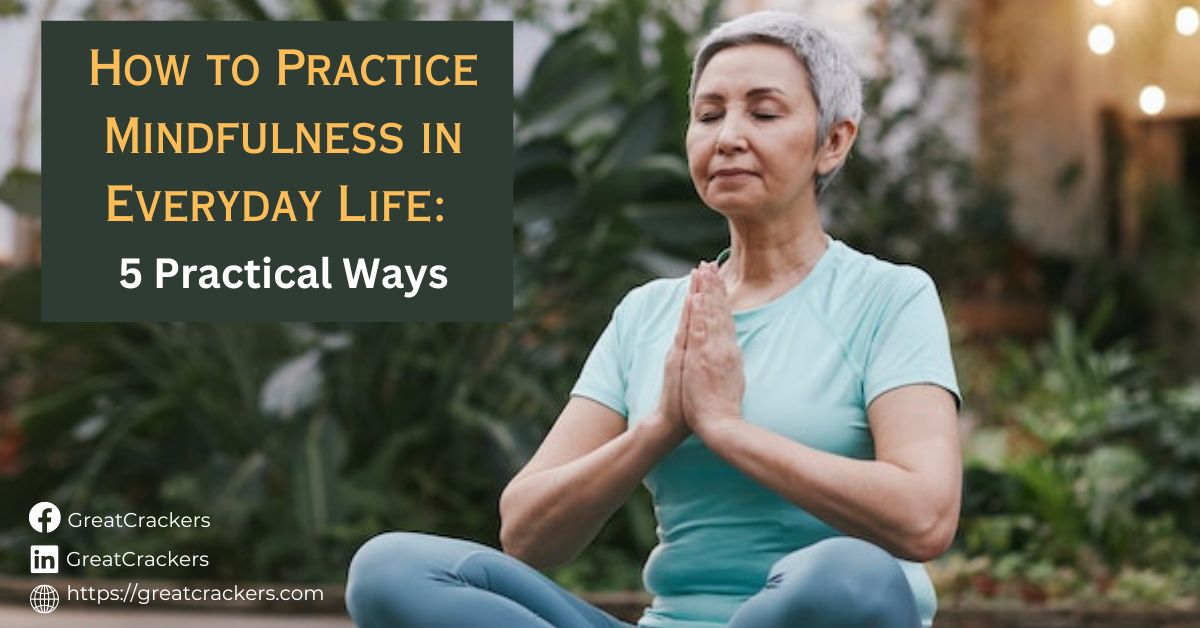How to Practice Mindfulness in Everyday Life: 5 Practical Ways
Are you always in a rush, thinking about the past or future, and missing the present’s beauty?
In a busy world like this, many people would say “yes” to that question. And that’s why learning about mindfulness is important. It helps you relieve stress, focus, and know yourself. Contrive Datum Insights Pvt Ltd predicts the Mindfulness Meditation Apps market will reach USD 307.1 million by 2030. It will grow by 12.4% from 2023 to 2030.
But, in this guide, we’ll explore how mindfulness can change your life. Also, you’ll learn the 5 ways to practice mindfulness every day. Now, read on to find calmness and understand yourself.
What is Mindfulness?
Mindfulness is a practice through which you bring focused attention to the present moment without judgment. It involves being attentive to your thoughts, feelings, and sensations as they come up.
That said, mindfulness has three core principles: First, not getting too upset or over-excited about things that happen. Second, notice what’s happening without holding onto it or trying to push it away. And third, stay focused on what’s happening right now.
Being mindful helps you become more kind to yourself, reduces stress, and makes your thoughts clearer. It also enables you to better understand your mind and what’s around you, making you feel happier and healthier overall.
5 Ways to Practice Mindfulness in Daily Life
According to the Mental Health Foundation, 51% of adults who felt stressed also felt depressed. This happens because many adults usually experience stress at work and home every day.
But the good news is that below are 5 practical ways to practice mindfulness in your daily life:
#1. Mindful Breathing Techniques
Mindful breathing is a way to help you feel calm and focused. And it involves paying attention to your breathing and taking slow, deep breaths. It’s a pretty cool technique to practice mindfulness because it can make you feel less stressed and more relaxed.
Of course, you can apply this technique anytime during the day by taking short breaks to notice your breath. By doing this, you’ll help yourself to be more aware and feel peaceful.
#2. Mindful Observation
Another way to practice mindfulness in your everyday life is mindful observation. And it’s about using your senses to notice things around you deeply. It’s like a tool that helps you to find beauty in everyday moments.
Yes, you can use mindful observation in a busy life. Imagine you’re a very busy person with a lot of things to do and pay attention to, this technique can still help you stay mindful.
For example, let’s say you walk to work every day. During your walk, you can take your time to notice the things around you. From hearing birds chirping, smelling the sweet flowers, and seeing how the sunlight made the buildings look beautiful. By paying attention to these things, you feel calmer and happier. You can also start to appreciate the city you live in more because every place has its hidden beauty.
By using this simple mindful observation, you can make your life better. You’ll learn to enjoy and appreciate the little wonders that happen every day. In the end, you’ll find joy and peace in your busy life.
#3. Mindful Presence
Mindful Presence means being fully in the moment during activities. When you play, study, or eat, give your full attention.
Interestingly, that rubs on how you communicate too. When you communicate mindfully, you listen carefully without interrupting, speak with kindness, and try to understand how others feel. Of course, being present and mindful makes life richer and connections stronger.
#4. Mindfulness and Gratitude
Mindfulness and gratitude are interconnected practices that enhance well-being. One of the common ways to apply this strategy is the use of a gratitude journal. If you don’t know, writing a gratitude journal means regularly making a list of things you’re thankful for.
Doing that helps you feel happy and positive about yourself, things, and your relationships. And when you are kind to others and show gratitude, your bond gets stronger and spreads happiness.
#5. Mindful Walking
Mindful walking is a simple yet powerful way to practice mindfulness in daily life. It involves walking slowly and attentively, focusing on each step and the sensations in the body.
When you pay attention to what’s around you and your breathing during a walk, it helps you feel calm and connected to the moment.
How to Practice Mindfulness for Anxiety
According to World Health Organisation (WHO), in 2019, there were 301 million people who had an anxiety disorder, and this included 58 million children and teenagers. This figure is to tell you that anxiety is a mental condition that millions of people struggle with around the globe.
However, the fascinating thing is that mindfulness can help you deal with anxiety. But to apply mindfulness in addressing anxiety, you need to acknowledge the presence of anxiety without judgment. And that involves observing its triggers, thoughts, and sensations. This way, you can cultivate self-awareness and a non-reactive response to reduce its impact.
1. Mindfulness Meditation for Anxiety
Mindfulness meditation for anxiety involves staying present and non-judgmentally aware. It helps you recognize and deal with your anxious feelings and thoughts, so they won’t take a strong grip on you. Some of the strategies below can be helpful to you:
2. Body Scan Meditation
Body Scan Meditation is a relaxing practice where you gently and individually focus your thoughts on various body areas, like your feet, knees, and neck. For example, as you do the meditation, you may feel your shoulders tense, but with mindful breathing and awareness, you release that tension. This practice helps promote a sense of calmness and reduces overall stress.
3. Breath Awareness Meditation
Breath Awareness Meditation is a simple technique where you sit quietly and focus solely on your natural breathing without trying to control it. For instance, you may find a quiet spot, sit with your eyes closed, and notice a gentle rise and fall of your chest as you breathe.
When thoughts or distractions arise, you gently bring your attention back to the breath, helping you become more centered and calm.
4. Grounding Techniques
These are mindfulness practices used for anxiety relief. These exercises bring focus to the present moment, helping you feel more stable and connected.
For instance, when feeling anxious, you can try the 5-4-3-2-1 technique. In this technique, you need to acknowledge five things you see, four things you touch, three things you hear, two things you smell, and one thing you taste. This exercise helps shift your focus away from worries and brings a sense of calmness.
Anchoring with Objects or Sounds
Anchoring with Objects or Sounds is a mindfulness technique where you choose a particular object or sound to restore your focus to the present moment. For example, you can carry a smooth stone in your pocket and touch it whenever you feel anxious. Feeling the texture and weight of the stone helps you reconnect with the here and now, reducing anxiety and promoting mindfulness.
How to Practice Mindfulness at Home
Have you ever heard the saying “Home sweet home”? It means that a home is a fantastic place to be. But sometimes, there can be so many things to do that you feel stressed or unfocused. Here are some easy and practical tips to help you be more mindful and relaxed at home:
1. Creating a Mindful Environment
To practice mindfulness at home, you should make your space calm and quiet by getting rid of stuff and not having too many things around. First, find a special spot just for meditation or relaxation.
Also, add some nature things like indoor plants, to make it feel peaceful. For example, you can create a comfortable corner with a cushion, plants, and gentle lights for your mindfulness time every day.
2. Mindful Eating
Mindful Eating is about enjoying food with all your senses, focusing on each bite. At home, you should create a peaceful eating environment. Sit at the table, put away distractions like phones or TV, and savor your meals slowly.
For example, while eating an apple, you can notice its crispness, and taste the sweetness. Also, you can feel grateful for it as nature’s gift.
3. Mindful Technology Use
Mindful Technology Use at home means setting screen limits and being aware of its impact. Allocate specific tech-free hours for family time. When you’re on social media, be mindful of emotions and time spent.
Let’s take for instance, limiting screen time to 1 hour before bedtime can improve sleep quality and family bonding. Mindfulness helps us create a healthy tech-life balance.
Overcoming Common Mindfulness Challenges
To overcome mindfulness challenges, you first need to know that it’s okay to feel restless and have your thoughts wander. You need to gently bring your attention back to the present moment when you get distracted. Even on busy days, try to set aside a little time every day for mindfulness.
However, remember, it takes time to get better, so be patient with yourself. Don’t be too hard on yourself and accept whatever thoughts and feelings come up without judging them. Be kind to yourself throughout the journey.
How to Integrate Mindfulness into a Busy Schedule
It can be overwhelming, but you can add mindfulness to your busy schedule. Yes, you can take short breaks to be present, like taking deep breaths. To do that, you have to manage your time mindfully, do important things first, and give yourself breaks.
For example, if you’re going to work, school, or places, you can look around and relax. Also, when doing chores, focus on your senses and enjoy the process. This way, you give mindfulness a chance to help you feel calm even when things are busy.
Mindfulness and Self-Compassion
Mindfulness and self-compassion work together. Be kind to yourself and accept that everyone makes mistakes. When things are tough, be as gentle to yourself as you would to your best friend. Instead of being hard on yourself, try to understand and comfort yourself. It’s okay to feel sad or stressed sometimes – we all do. Mindfulness helps us show love and care to ourselves.
The Power of Mindfulness in Stress Management
Mindfulness is a powerful way to manage stress. At home, take some time to focus on your breath and how your body feels. Don’t worry about the past or the future, just enjoy the present moment to feel less anxious. Mindfulness gets stronger with techniques like body scans, yoga, and meditation.
In other words, when you have lots of work and feel overwhelmed, try this: Take deep breaths, acknowledge your feelings, and concentrate on what you’re doing. It can make you feel less stressed. By practicing mindfulness, you can handle life’s difficulties better and feel more peaceful inside.
Final Thoughts
Practicing mindfulness in everyday life means making it a part of who you are, not just something you do once in a while. Thus, mindfulness can become a natural part of our lives by taking small steps regularly. It helps us notice and enjoy each moment fully, making us feel more connected to ourselves and others.
Also, mindfulness can make a big difference in your life. It helps you pay better attention, not react too quickly, and care more about others. In addition, mindfulness makes you feel stronger, happier, and more satisfied, even when life is tough every day.








